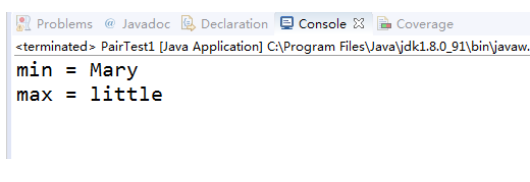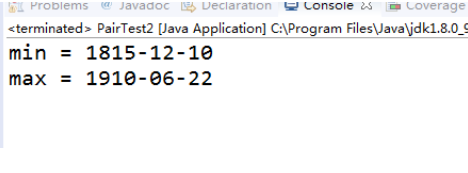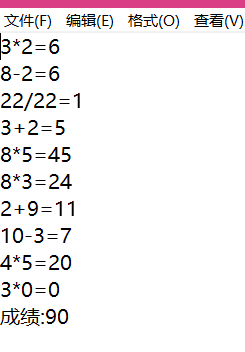理论学习知识
泛型类的定义:一个泛型类(generic class)就是具有一个或多个类型变量的类,即创建用类型作为参数的类。
如一个泛型类定义格式如下: class Generics<K,V> 其中的K和V是类中的可变类型参数。
Pair类引入了一个类型变量T,用尖括号(<>) 括起来,并放在类名的后面。
泛型类可以有多个类型变量。例如: public class Pair<t, u> { … }
类定义中的类型变量用于指定方法的返回类型以 及域、局部变量的类型。
泛型方法:
除了泛型类外,还可以只单独定义一个方法作为泛型方法,用于指定方法参数或者返回值为泛型类型,留待方法调用时确定。
泛型方法可以声明在泛型类中,也可以声明在普通类中。
泛型变量上界的说明
NumberGeneric类所能处理的泛型变量类型需和Number有继承关系;
extends关键字所声明的上界既可以是一个类,也可以是一个接口;
<T extends Bounding Type>表示T应该是绑定类型的子类型。
泛型变量下界的说明
通过使用super关键字可以固定泛型参数的类型为某种类型或者其超类
当程序希望为一个方法的参数限定类型时,通常可以使用下限通配符
通配符:
“?”符号表明参数的类型可以是任何一种类型,它和参数T的含义是有区别的。T表示一种未知类型,而“?”表示任何一种类型。这种通配符一般有以下三种用法:
单独的?,用于表示任何类型。
? extends type,表示带有上界。
? super type,表示带有下界。
1、实验目的与要求
(1) 理解泛型概念;
(2) 掌握泛型类的定义与使用;
(3) 掌握泛型方法的声明与使用;
(4) 掌握泛型接口的定义与实现;
(5)了解泛型程序设计,理解其用途。
2、实验内容和步骤
实验1: 导入第8章示例程序,测试程序并进行代码注释。
测试程序1:
编辑、调试、运行教材311、312页 代码,结合程序运行结果理解程序;
在泛型类定义及使用代码处添加注释;
掌握泛型类的定义及使用。
程序源代码及其注释:
package pair1; /** * @version 1.00 2004-05-10 * @author Cay Horstmann */ public class Pair<T> //Pair类引入了一个类型变量T,用尖括号括起来 { private T first; private T second; //指方法的返回类型以及域和局部变量的类型 public Pair() { first = null; second = null; } public Pair(T first, T second) { this.first = first; this.second = second; } public T getFirst() { return first; } public T getSecond() { return second; } public void setFirst(T newValue) { first = newValue; } public void setSecond(T newValue) { second = newValue; } }
package pair1; /** * @version 1.01 2012-01-26 * @author Cay Horstmann */ public class PairTest1 { public static void main(String[] args) { String[] words = { "Mary", "had", "a", "little", "lamb" }; Pair<String> mm = ArrayAlg.minmax(words); System.out.println("min = " + mm.getFirst()); System.out.println("max = " + mm.getSecond()); } } class ArrayAlg { /** * Gets the minimum and maximum of an array of strings. * @param a an array of strings * @return a pair with the min and max value, or null if a is null or empty */ public static Pair<String> minmax(String[] a)//使用静态方法来用泛型方法 { if (a == null || a.length == 0) return null; String min = a[0]; String max = a[0]; for (int i = 1; i < a.length; i++) { if (min.compareTo(a[i]) > 0) min = a[i]; if (max.compareTo(a[i]) < 0) max = a[i]; } return new Pair<>(min, max); } }
程序测试结果如下所示:

测试程序2:
编辑、调试运行教材315页 PairTest2,结合程序运行结果理解程序;
在泛型程序设计代码处添加相关注释;
掌握泛型方法、泛型变量限定的定义及用途。
程序源代码及其注释:
package pair2; /** * @version 1.00 2004-05-10 * @author Cay Horstmann */ public class Pair<T> { private T first; private T second; public Pair() { first = null; second = null; } public Pair(T first, T second) { this.first = first; this.second = second; } public T getFirst() { return first; } public T getSecond() { return second; } public void setFirst(T newValue) { first = newValue; } public void setSecond(T newValue) { second = newValue; } }
package pair2; import java.time.*; /** * @version 1.02 2015-06-21 * @author Cay Horstmann */ public class PairTest2 { public static void main(String[] args) { LocalDate[] birthdays = { LocalDate.of(1906, 12, 9), // G. Hopper LocalDate.of(1815, 12, 10), // A. Lovelace LocalDate.of(1903, 12, 3), // J. von Neumann LocalDate.of(1910, 6, 22), // K. Zuse }; Pair<LocalDate> mm = ArrayAlg.minmax(birthdays); System.out.println("min = " + mm.getFirst()); System.out.println("max = " + mm.getSecond()); } } class ArrayAlg { /** Gets the minimum and maximum of an array of objects of type T. @param a an array of objects of type T @return a pair with the min and max value, or null if a is null or empty */ public static <T extends Comparable> Pair<T> minmax(T[] a) { if (a == null || a.length == 0) return null; T min = a[0]; T max = a[0]; for (int i = 1; i < a.length; i++) { if (min.compareTo(a[i]) > 0) min = a[i]; if (max.compareTo(a[i]) < 0) max = a[i]; } return new Pair<>(min, max); } }
程序测试结果如下所示:

测试程序3:
用调试运行教材335页 PairTest3,结合程序运行结果理解程序;
了解通配符类型的定义及用途。
程序的源代码及其注释;
package pair3; /** * @version 1.01 2012-01-26 * @author Cay Horstmann */ public class PairTest3 { public static void main(String[] args) { Manager ceo = new Manager("Gus Greedy", 800000, 2003, 12, 15); Manager cfo = new Manager("Sid Sneaky", 600000, 2003, 12, 15); Pair<Manager> buddies = new Pair<>(ceo, cfo); printBuddies(buddies); ceo.setBonus(1000000); cfo.setBonus(500000); Manager[] managers = { ceo, cfo }; Pair<Employee> result = new Pair<>(); minmaxBonus(managers, result); System.out.println("first: " + result.getFirst().getName() + ", second: " + result.getSecond().getName()); maxminBonus(managers, result); System.out.println("first: " + result.getFirst().getName() + ", second: " + result.getSecond().getName()); } public static void printBuddies(Pair<? extends Employee> p) //? extends type,表示带有上界 { Employee first = p.getFirst(); Employee second = p.getSecond(); System.out.println(first.getName() + " and " + second.getName() + " are buddies."); } //"?"在这儿是通配符,符号表明参数的类型可以是任何一种类型,它和参数T的含义是有区别的 public static void minmaxBonus(Manager[] a, Pair<? super Manager> result) { if (a.length == 0) return; Manager min = a[0]; Manager max = a[0]; for (int i = 1; i < a.length; i++) { if (min.getBonus() > a[i].getBonus()) min = a[i]; if (max.getBonus() < a[i].getBonus()) max = a[i]; } result.setFirst(min); result.setSecond(max); } //T表示一种未知类型,而“?”表示任何一种类型 public static void maxminBonus(Manager[] a, Pair<? super Manager> result) { minmaxBonus(a, result); PairAlg.swapHelper(result); // swapHelper捕获通配符类型 } // 不能写公共静态<T超级管理器> ... } class PairAlg { public static boolean hasNulls(Pair<?> p) { return p.getFirst() == null || p.getSecond() == null; } public static void swap(Pair<?> p) { swapHelper(p); } public static <T> void swapHelper(Pair<T> p) { T t = p.getFirst(); p.setFirst(p.getSecond()); p.setSecond(t); } }
package pair3; import java.time.*; public class Employee { private String name; private double salary; private LocalDate hireDay; public Employee(String name, double salary, int year, int month, int day) { this.name = name; this.salary = salary; hireDay = LocalDate.of(year, month, day); } public String getName() { return name; } public double getSalary() { return salary; } public LocalDate getHireDay() { return hireDay; } public void raiseSalary(double byPercent) { double raise = salary * byPercent / 100; salary += raise; } }
package pair3; public class Manager extends Employee { private double bonus; /** @param name the employee's name @param salary the salary @param year the hire year @param month the hire month @param day the hire day */ public Manager(String name, double salary, int year, int month, int day) { super(name, salary, year, month, day); bonus = 0; } public double getSalary() { double baseSalary = super.getSalary(); return baseSalary + bonus; } public void setBonus(double b) { bonus = b; } public double getBonus() { return bonus; } }
package pair3; /** * @version 1.00 2004-05-10 * @author Cay Horstmann */ public class Pair<T> { private T first; private T second; public Pair() { first = null; second = null; } public Pair(T first, T second) { this.first = first; this.second = second; } public T getFirst() { return first; } public T getSecond() { return second; } public void setFirst(T newValue) { first = newValue; } public void setSecond(T newValue) { second = newValue; } }
程序测试结果如下所示;

实验2:编程练习:
编程练习1:实验九编程题总结
l 实验九编程练习1总结(从程序总体结构说明、模块说明,目前程序设计存在的困难与问题三个方面阐述)。
实验通过自定义一个类和main类实现。
main类中主要实现了文件的调用,输出相应实验内容。
而自定义类则定义了文件中的相关变量和接口的实现。
困难与问题:主要问题是接口和类的联系和实现比较迷惑。
import java.io.BufferedReader; import java.io.File; import java.io.FileInputStream; import java.io.FileNotFoundException; import java.io.IOException; import java.io.InputStreamReader; import java.util.ArrayList; import java.util.Arrays; import java.util.Collections; import java.util.Scanner; public class main{ private static ArrayList<person> Personlist; public static void main(String[] args) { Personlist = new ArrayList<>(); Scanner scanner = new Scanner(System.in); File file = new File("D:\\身份证号.txt"); try { FileInputStream fis = new FileInputStream(file); BufferedReader in = new BufferedReader(new InputStreamReader(fis)); String temp = null; while ((temp = in.readLine()) != null) { Scanner linescanner = new Scanner(temp); linescanner.useDelimiter(" "); String name = linescanner.next(); String ID = linescanner.next(); String sex = linescanner.next(); String age = linescanner.next(); String place =linescanner.nextLine(); person Person = new person(); Person.setname(name); Person.setID(ID); Person.setsex(sex); int a = Integer.parseInt(age); Person.setage(a); Person.setbirthplace(place); Personlist.add(Person); } } catch (FileNotFoundException e) { System.out.println("查找不到信息"); e.printStackTrace(); } catch (IOException e) { System.out.println("信息读取有误"); e.printStackTrace(); } boolean isTrue = true; while (isTrue) { System.out.println("1:按姓名字典序输出人员信息"); System.out.println("2:查询最大年龄与最小年龄人员信息"); System.out.println("3:输入你的年龄,查询与你最近人的姓名、身份证号、年龄、性别和出生地;"); System.out.println("4:查询是否有同乡"); System.out.println("5:退出"); int nextInt = scanner.nextInt(); switch (nextInt) { case 1: Collections.sort(Personlist); System.out.println(Personlist.toString()); break; case 2: int max=0,min=100;int j,k1 = 0,k2=0; for(int i=1;i<Personlist.size();i++) { j=Personlist.get(i).getage(); if(j>max) { max=j; k1=i; } if(j<min) { min=j; k2=i; } } System.out.println("年龄最大:"+Personlist.get(k1)); System.out.println("年龄最小:"+Personlist.get(k2)); break; case 3: System.out.println("年龄:"); int yourage = scanner.nextInt(); int near=agenear(yourage); int d=yourage-Personlist.get(near).getage(); System.out.println(""+Personlist.get(near)); break; case 4: System.out.println("你的家乡?"); String find = scanner.next(); String place=find.substring(0,3); String place2=find.substring(0,3); for (int i = 0; i <Personlist.size(); i++) { if(Personlist.get(i).getbirthplace().substring(1,4).equals(place)) System.out.println(""+Personlist.get(i)); } break; case 5: isTrue = false; System.out.println("退出程序!"); break; default: System.out.println("输入有误"); } } } public static int agenear(int age) { int j=0,min=53,d=0,k=0; for (int i = 0; i < Personlist.size(); i++) { d=Personlist.get(i).getage()-age; if(d<0) d=-d; if (d<min) { min=d; k=i; } } return k; } }
public class person implements Comparable<person> { private String name; private String ID; private int age; private String sex; private String birthplace; public String getname() { return name; } public void setname(String name) { this.name = name; } public String getID() { return ID; } public void setID(String ID) { this.ID= ID; } public int getage() { return age; } public void setage(int age) { this.age= age; } public String getsex() { return sex; } public void setsex(String sex) { this.sex= sex; } public String getbirthplace() { return birthplace; } public void setbirthplace(String birthplace) { this.birthplace= birthplace; } public int compareTo(person o) { return this.name.compareTo(o.getname()); } public String toString() { return name+"\t"+sex+"\t"+age+"\t"+ID+"\t"+birthplace+"\n"; } }
练习2总结(从程序总体结构说明、模块说明,目前程序设计存在的困难与问题三个方面阐述)。
这个实验主要是通过在主函数中用round() 方法实现随机题目的产生和将题目数字限制在10以内,然后添加异常处理,实现文件的输出。
困难与问题:对于将结果通过txt文件输出的相关代码有点陌生。
编程练习2:采用泛型程序设计技术改进实验九编程练习2,使之可处理实数四则运算,其他要求不变。
程序源代码:
package cc; public class SF<T> { private T a; private T b; public SF() { a = null; b = null; } public SF(T a, T b) { this.a = a; this.b = b; } public int SF1(int a,int b) { return a+b; } public int SF2(int a,int b) { return a-b; } public int SF3(int a,int b) { return a*b; } public int SF4(int a,int b) { if(b!=0) return a/b; else return 0; } }
package cc; import java.io.FileNotFoundException; import java.io.PrintWriter; import java.util.Scanner; public class Demo { public static void main(String[] args) { Scanner in = new Scanner(System.in); SF counter=new SF(); PrintWriter out = null; try { out = new PrintWriter("text.txt"); } catch (FileNotFoundException e) { // TODO Auto-generated catch block e.printStackTrace(); } int sum = 0; for (int i = 0; i <10; i++) { int a = (int) Math.round(Math.random() * 10); int b = (int) Math.round(Math.random() * 10); int m= (int) Math.round(Math.random() * 3); switch(m) { case 0: System.out.println(a + "+" + b + "="); int d0 = in.nextInt(); out.println(a + "+" + b + "=" + d0); if (d0 == counter.SF1(a, b)) { sum += 10; System.out.println("恭喜答案正确"); } else { System.out.println("抱歉,答案错误"); } break; case 1: while (a < b) { int x = a; a = b; b = x; } System.out.println(a + "-" + b + "="); int d1 = in.nextInt(); out.println(a + "-" + b + "=" + d1); if (d1 == counter.SF2(a, b)) { sum += 10; System.out.println("恭喜答案正确"); } else { System.out.println("抱歉,答案错误"); } break; case 2: System.out.println(a + "*" + b + "="); int d2 = in.nextInt(); out.println(a + "*" + b + "=" + d2); if (d2 ==counter.SF3(a, b)) { sum += 10; System.out.println("恭喜答案正确"); } else { System.out.println("抱歉,答案错误"); } break; case 3: while (b == 0 || a % b != 0) { a = (int) Math.round(Math.random() * 100); b = (int) Math.round(Math.random() * 100); } System.out.println(a + "/" + b + "="); int d3 = in.nextInt(); out.println(a + "/" + b + "=" + d3); if (d3 == counter.SF4(a, b)) { sum += 10; System.out.println("恭喜答案正确"); } else { System.out.println("抱歉,答案错误"); } break; } } System.out.println("成绩"+sum); out.println("成绩:"+sum); out.close(); } }


总结:这周学习了泛型程序设计,学习了简单的泛型方法,和定义一个简单的泛型类,这周的知识是一项全新的技术,我掌握的并不是很好,对知识的理解还不到位,我会在今后的学习中更加努力,争取理解和消化这项技术。





